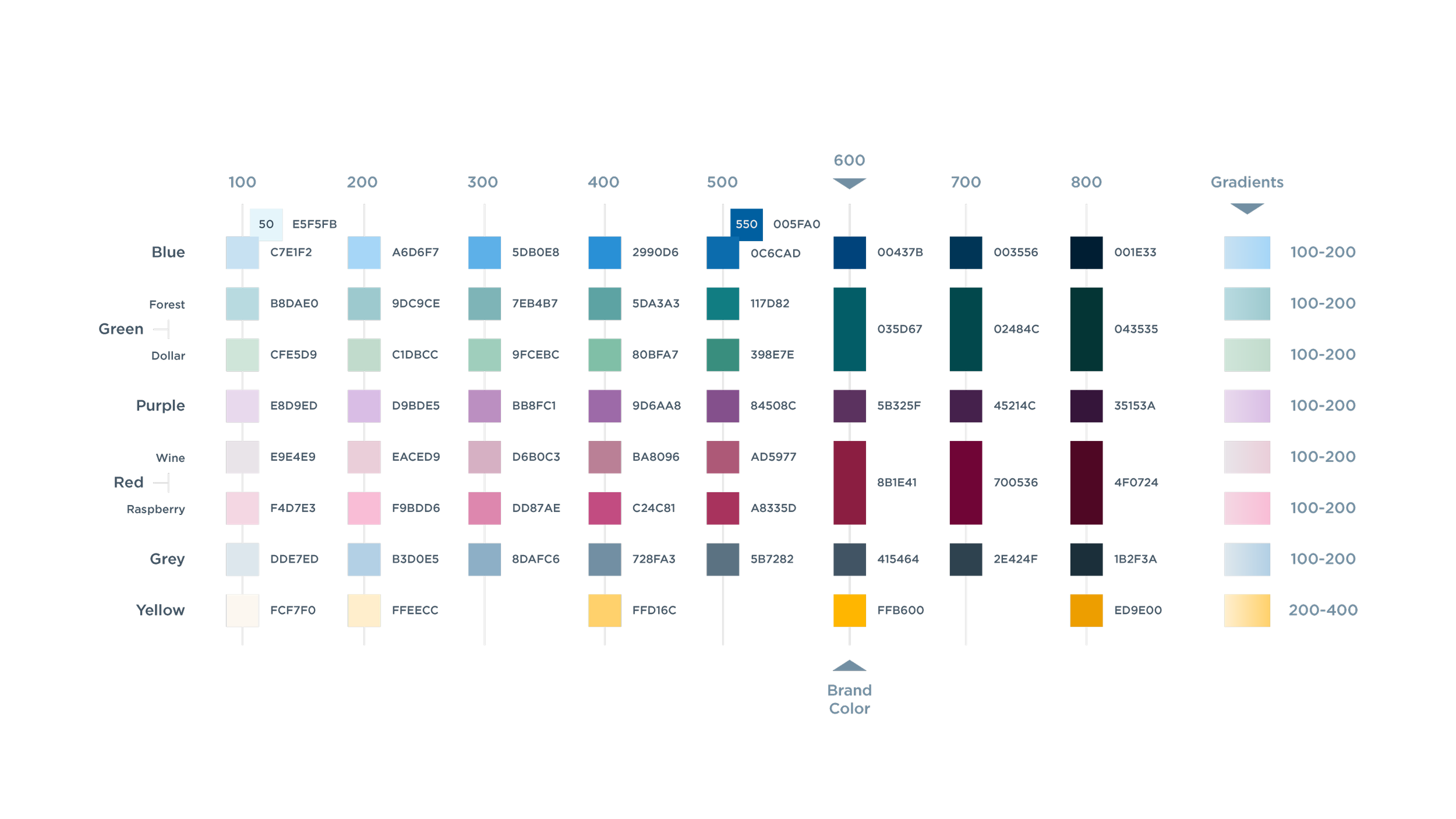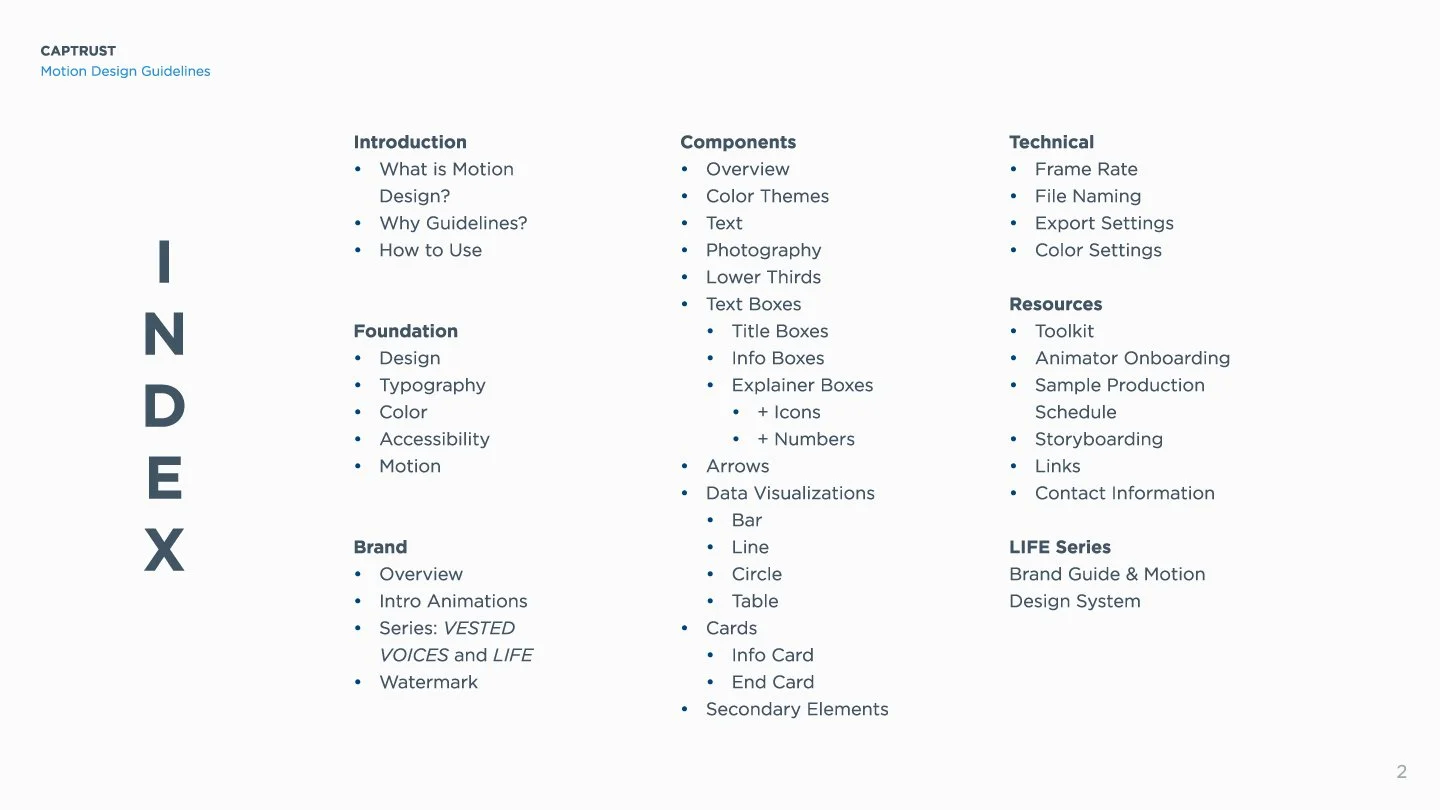CAPTRUST
Motion Design System — Guidelines & Toolkit
With the ultimate goal of super charging their in-house video team, we partnered with CAPTRUST to define, design, and deliver a completely refreshed motion design system.
This process took roughly a year and we used a 3 phases framework to guide the process through an audit of their existing motion system, updating the look & feel of their video content, capturing these improvements in standardized motion guidelines, and building out a new & enhanced motion design toolkit.
*Updated intro animation for CAPTRUST videos. Scroll down to Phase 3 to see the template in action.
Phase 1:
Discovery
“ What makes a CAPTRUST video successful? ”
The initial phase of building out a robust motion design system is arguably the most important. Here is where we do deep dive into brand, channels, and competitors, as well as conduct a thorough audit of the existing video production pipeline, toolkit, and metrics for success.
Once we have a clear understanding of where things are, we conduct an in-person discovery session, drilling deeper into specific questions that we unearthed in the audit.
Through our discovery session, we distill our insights into a creative brief and create a prioritized list of goals for the project. For instance, an ability to scale video production while maintaining quality was a paramount goal for CAPTRUST, so that became a top priority moving forward. Other major goals included refreshing the look & feel of the design elements, maintaining brand cohesion while building on established brand equity, and modernizing the widely-used, internal motion toolkit (which we first launched 5 years prior).
Phase 2:
Look Development
Based on feedback from Phase 1, as well as some references that the client provided, we brought several visual concepts to the client in the form of moodboards and mockups for review and discussion.
Once a core visual direction was identified for the entire system, we proceeded to dial in designs for individual components through multiple rounds of feedback and iteration, until they met carefully considered motion parameters and (of equal importance) received enthusiastic client approval.
After we gained client approval on all key elements of the refreshed visuals, it was time to define and standardize these principles in a set of comprehensive guidelines. The motion guidelines had to be written in a way that a freelance motion designer could jump in and understand the brand, have design-specific questions answered, and could act as a living reference as they progressed through a project. We even included additional resources, such as sample production schedules and storyboarding templates.
In order to refresh the look & feel, it was necessary to expand on the existing brand color palette, so we developed a color system that allows for visual complexity while maintaining a sense of structure rooted in the core colors of CAPTRUST. Numbering the groups from lightest to darkest allowed us to bake these color combinations directly into our toolkit assets in Phase 3.
Side note: We decided early on to use a slide deck platform called Pitch as the backbone of the guidelines because of their excellent support for video, ease of collaboration, and ability to use custom fonts, which allowed us to white-label the guidelines to match the client’s brand.
The component naming convention established in the guidelines is also used throughout the toolkit, maintaining consistency and clarity within a dense system.
Phase 3:
Motion Toolkit
Brand look is established. Guidelines are set. Time to get nerdy.
The most technically challenging phase of this project is building a multifunctional motion toolkit that is easy enough for junior editors to use when adding simple graphics in Premiere Pro, yet robust enough that a seasoned animator can build out highly complex scenes for a variety of uses.
So, to ensure we understood the goals for each component of the toolkit, we conducted another discovery session with the video team focused specifically on workflow, with scalability in mind.
We ended up creating over a dozen MOGRTs with tons of attributes, variables and functionalities - multiple color palettes, toggles for secondary elements, text inputs, and location dropdowns, to name just a few. All of these MOGRTs also live inside a primary AEP that contains the source compositions and additional comps with expanded capabilities for ultimate customization.
CAPTRUST’s video team is now unstoppable.
Have we made their jobs too easy? Maybe :)
*This video shows the inner workings of the intro animation MOGRT from the Motion Toolkit, allowing video editors to easily customize various parts of a motion graphic scene without leaving Premiere Pro.
About CAPTRUST
CAPTRUST Financial Advisors, headquartered in Raleigh, NC, is one of the largest independent retirement plan and investment advisory firms in the country and manages over $1T in assets . CAPTRUST specializes in providing consultative advisory services to retirement plan sponsors, endowments, foundations, institutional investors, executives, and high net-worth individuals.
CAPTRUST’s video production team crafts a variety of video types for their wide-ranging audiences; video is a critical component to their communication strategy. With a lean marketing team, they continually punch above their weight, producing tons of high quality, meaningful video content.
Credits
Client: CAPTRUST
Creative/Art Direction & Motion Design: Adam Pyburn
Production: Ali Ferrari
Graphic & Motion Design: Raphael Koehler-Derrick Graphic Design: Mithra Krishnan
Toolkitting: Nic Dean


















